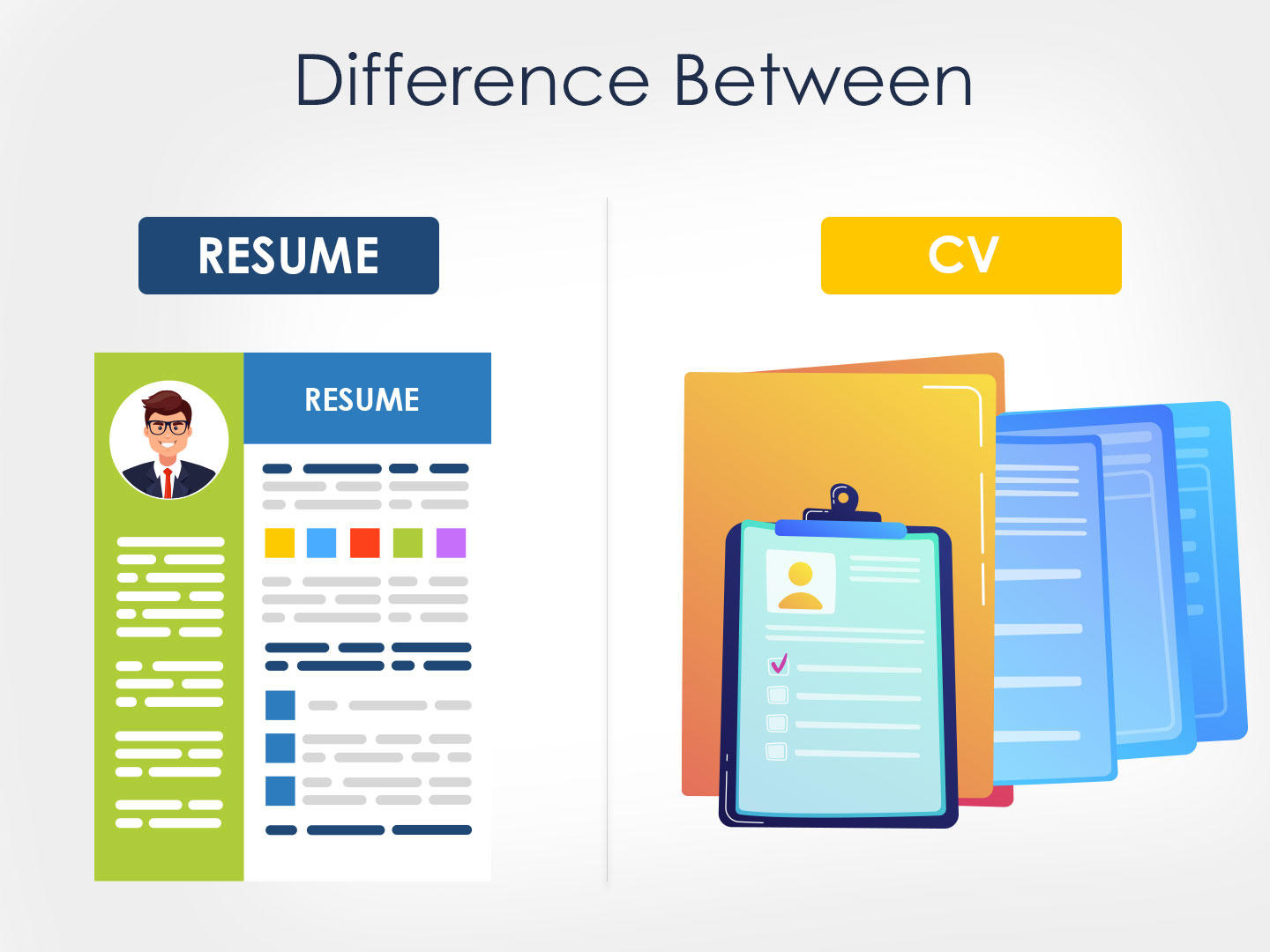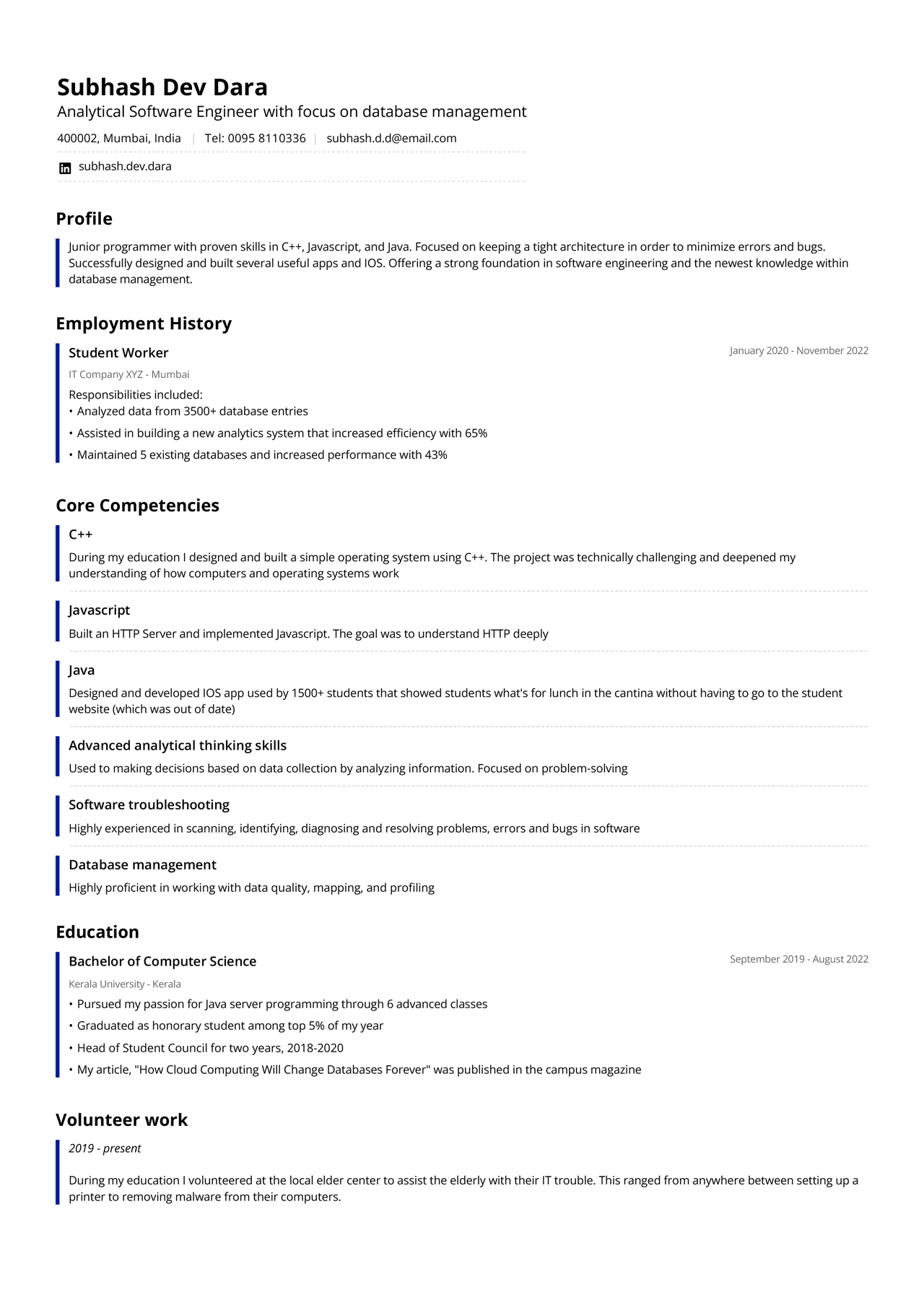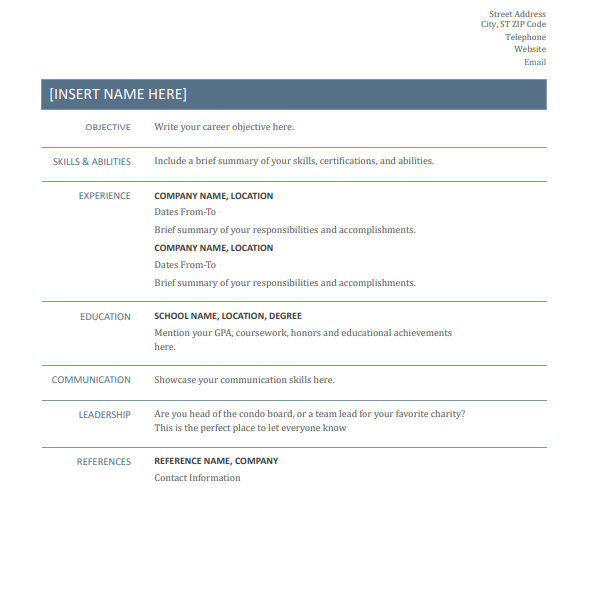Applying for a job for the first time can be confusing. You may have come across the terms CV and resume during your research. Knowing the difference between a CV and a resume is crucial to present yourself as a strong candidate when applying for a job.
In India, the terms “resume” and “CV” are used interchangeably.
Curriculum Vitae (CV) is Latin for "course of life." In contrast, a resume is French for "summary." You must prepare a resume and a CV if you are applying for both academic and industry (private or public sector) positions. Both CVs and resumes:
- Are tailored for the specific job/company you are applying to
- Should represent you as the best-qualified candidate
- Are used to get you an interview
- Do not usually include personal interests
Check out the best job sites for freshers in India.


Differences between a Resume and a CV
The differences between a resume and a CV include the document’s length and the ability to customize layout options. Additionally, the individual's region and career path must be considered when deciding which is appropriate to use. Here is how they differ fundamentally:
- Length: While most people strive to keep their resume as concise as possible, ideally only one to two pages, a CV can run several pages in length. That’s because a CV includes more information than a resume.
- Experience/career type: Often, CVs are used by people in academic roles. You may have a CV if you are currently applying to or have graduated from a master’s or doctoral program or if you work as a professor or researcher at an academic institution.
- Ability to customize: A CV is a static document that does not change. You may add new information to a CV throughout your professional career, but the information will not change based on where you’re applying. On the other hand, a resume is often tailored to highlight specific skills or experiences relevant to the position or industry.
- Geography: In other regions of the world, such as the U.K., New Zealand, and parts of Europe, employers use the term CV to describe both CV and resume-style documents. They don’t use the term “resume” at all. In South Africa, Australia and India, the terms CV and resume are often used interchangeably. However, in the U.S., a resume and a CV are two distinctly different types of documents.
Regarding the differences between CVs and resumes, keep in mind that employers in certain countries may have specific preferences — while resumes are the most commonly used format for job applicants in the US, employers in other countries may request a CV.
Find out all about a cover letter and its importance in a job application.
Components of a CV
A CV is a very in-depth document that describes your career journey step-by-step, including all sorts of personal information. You can look at the CV as a comprehensive description of everything you have ever done, all the achievements you are proud of, and all the publications that bear your name.
There are three different types of CV formats:
- Chronological CV—This is the most commonly used curriculum vitae format, and it lists your work history starting with the most recent position. Use a chronological CV if you have prior work experience and want to highlight your skills and project experience.
- Functional CV—Also known as a skill-based CV, this format focuses on your skills and work experience instead of your chronological work history. While it is not as widely used as a chronological CV, a functional CV can be preferable if you have not worked previously, have gaps in your career history, or want to change careers.
- Combination CV—This format combines a chronological CV and a functional CV. Using a combination CV, you can highlight your skills and provide a chronological work history.
The elements you include in a CV will depend on what you are applying for, so be sure to incorporate the most relevant information to support your candidacy in your CV.
- Personal details and contact information. Most CVs start with contact information and personal data but avoid superfluous details, such as religious affiliation, children's names, etc.
- Education and qualifications. Be sure to include the names of institutions and dates attended in reverse order: Ph.D., Masters, Undergraduate.
- Work experience/employment history. The most widely accepted style of employment record is the chronological curriculum vitae. Your career history is presented in reverse, starting with the most recent appointment. More emphasis/information should be placed on your most recent jobs.
- Skills. Include computer skills, foreign language skills, and other recent training relevant to the applied role.
- Training / Graduate Fieldwork / Study Abroad
- Dissertations / Theses
- Research experience
- Teaching experience
- Publications
- Presentations, lectures, and exhibitions
- Grants, scholarships, fellowships, and assistantships
- Awards and honors
- Technical, computer, and language skills
- Professional licenses, certifications, and memberships
You must update your CV every time you accomplish something new academically or professionally. Meaning whenever you get a new job, publish something new, obtain a new certificate, and so on. There is no rule of thumb on how long a CV should be - depending on the amount of experience, it can range from 2 to 8 pages.

Best CV Format for Freshers
Know what to include and how to format the information. Choose an appropriate format. Make sure you choose a curriculum vitae format appropriate for the position you are applying for. If you are applying for a fellowship, for example, you won't need to include the personal information that may be included in an international CV.

There are a few ways you can write your fresher CV. The two we would recommend are the reverse-chronological CV and the combination CV. It is possible to make both of these formats work for you, even if you don’t have much work experience yet. Instead, focus on your courses, achievements, skills, internships, volunteering, and awards.
The best CV format for freshers does two things: it includes all the right sections and has a clear and elegant overall layout. Your fresher CV should include these sections:
- A header that includes your personal and contact details
- A career objective that summarises what you have to offer
- A work experience section, if you have some relevant experience already
- An education section that zooms right in on your academic performance
- A short list of proven skills that match the job requirements
- One or two additional sections that fill in any strengths not mentioned elsewhere.
Check out the best formats for a fresher resume.
The overall layout of a good fresher CV for job applications is clear and easy to navigate. Use large, well-separated subheadings and plenty of white space to divide your resume into sections. An understated, professional-looking font will go a long way to making your CV hold up just as well under a closer reading. Use something that won’t draw attention to itself.
Components of a Resume
A resume is a short, straight-to-the-point document created to apply to a specific job. Unlike the CV, you should try to keep a resume as short as possible. In 99% of the cases, you’d want to keep your resume to the 1-page max. If you have 15+ years of experience or believe the extra information you can mention can add value to your application, you can make it 2 pages tops.
In a resume, you only mention the aspects of your work experience and skills relevant to the job you’re applying for. A good resume highlights specific contributions you have made in your previous work and showcases how your different skills can be useful for the position you are applying to.
Generally, there are four standard types of resumes:
- Chronological resume—Similar to the chronological CV, this resume format lists your work experience in descending chronological order, starting with your most recent position. A chronological resume is considered the standard format that many hiring managers prefer.
- Functional resume—This format emphasizes skills and experience over employment history. A functional resume format is ideal if you are changing careers or have little work experience.
- Combined resume—A combined resume mixes chronological and functional formats. This resume highlights your skills and experience before listing your employment history in descending chronological order.
- Targeted resume—A targeted resume is a customized document highlighting your qualifications and experience for a specific job opening. Generally, a targeted resume requires more preparation since it is tailored to one prospective company at a time.
The resume is usually accompanied by a cover letter stating your intent to apply for the job. The cover letter builds upon the skills and experience you have touched upon in your resume, explaining how they will help you excel at the job you’re applying for.
Sample Resume for Freshers
Follow these important steps to write a winning resume as you start your professional journey.
Stick to the Job Description
Every resume should be specific to the skills and qualities needed to succeed in the role you are applying for and show you have the same core values as the employer. Reading the job description before you write your resume will help you choose the keywords you should include throughout your resume.
Check out the best cover letter format for freshers in India.
Contact Information
The first section of your resume should state your contact information, including your name, address (or city and state), phone number, and email address. Some people prefer not to include their entire address, but if you live close to the office of the job you are applying for, including your full address may help you stand out.
Some candidates prefer to include links to social media profiles, personal websites, personal blogs, or personal portfolios in this section. If you include these links in your resume, it is important to make sure everything on your profile is professional and portrays the personal, professional brand you want.
Summary Statement
The next section of your resume should be a personal summary that states who you are as a professional, your career goals, and why you are the best candidate for the position you are applying for. A great resume summary statement should convey your knowledge and passion for the role you are applying to and how you will be of value to the employer.

Highlight Your Skills
Your next step is to choose the technical hard and soft skills you have most relevant to being successful in the position you are applying for. You can often find specific skills the employer is looking for listed throughout the job description. When listing your skills it is best to use a one- or two-column format that states the skill and your level of experience with the skill.
Include Education, Training, Certifications
The next section of your resume should highlight your most relevant education, training, and certifications. This could include your major and minor in college, professional licenses and certifications, certificate courses taken in college, and additional professional training. You could also highlight this information in this section if you earned honors, exceptional grades, or scholarships.
Find complete job search help in this comprehensive guide for freshers in India.
Relevant Experience
Not having professional work experience does not mean you don’t have any relevant experience you can include in your resume. While this section will not be the focus of your resume, you can include this section if you have work experiences such as internships, volunteer work, educational projects, or relevant coursework that provides evidence for your skills and knowledge. This section should include the name of the experience or project and a brief description of what you did in these experiences relevant to the position you are applying for.












